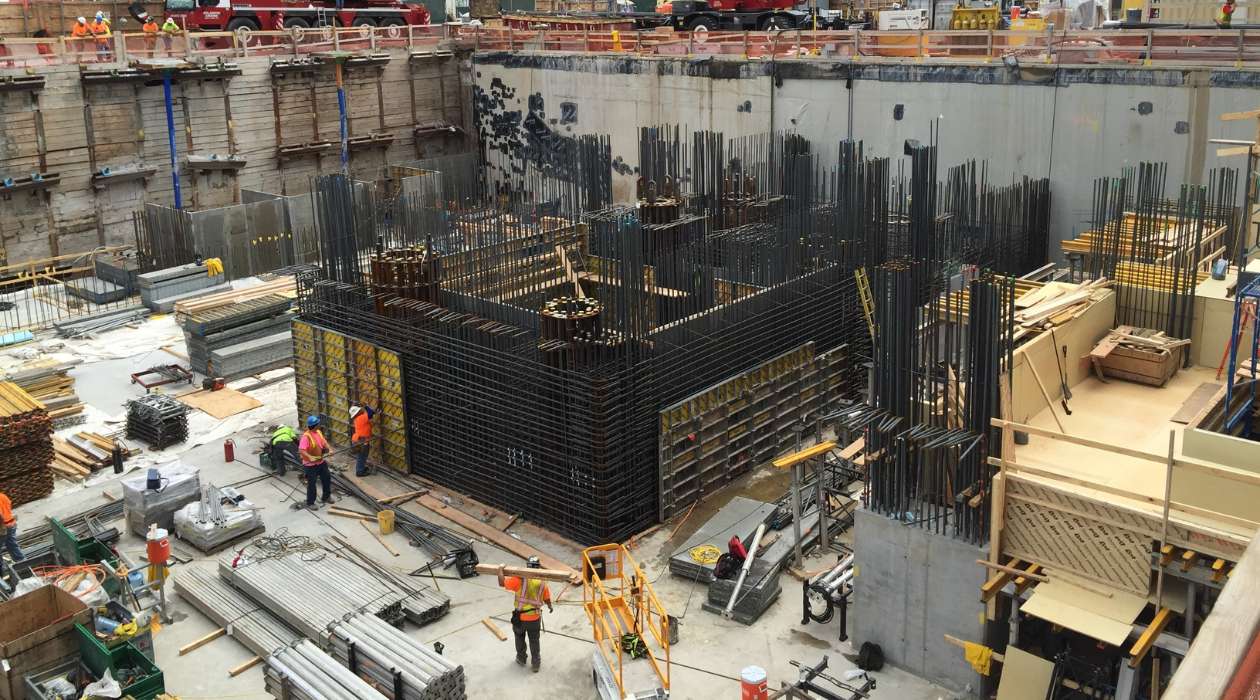Home>diy>Building & Construction>What Construction Companies Are Publicly Traded


Building & Construction
What Construction Companies Are Publicly Traded
Modified: October 20, 2024
Discover the top publicly traded construction companies in the building construction industry. Explore their stocks, financials, and market performance.
(Many of the links in this article redirect to a specific reviewed product. Your purchase of these products through affiliate links helps to generate commission for Storables.com, at no extra cost. Learn more)
Introduction
Welcome to the world of construction companies and the fascinating realm of public trading. In this article, we will explore the topic of which construction companies are publicly traded, uncovering the advantages and disadvantages of these companies going public, as well as providing a list of publicly traded construction companies that you can consider when investing.
Construction companies play a vital role in shaping the built environment we live in, from towering skyscrapers to intricate infrastructure projects. With their expertise in constructing buildings, bridges, roads, and other structures, these companies are at the forefront of the modernization and development of cities and countries around the world.
Going public is a significant step for any company, as it involves offering shares of its stock for public ownership. This allows individuals and institutional investors to buy and sell shares, providing a means for the company to raise funds for growth and expansion. For construction companies, going public can open up new opportunities and provide a platform for increased visibility and funding.
Publicly traded construction companies have certain advantages that make them an attractive proposition for both investors and the companies themselves. Firstly, going public can provide access to a broader pool of capital. By offering shares on the stock market, construction companies can raise funds to finance larger and more ambitious projects, fueling their growth and expansion.
Additionally, going public can enhance a construction company’s brand image and reputation. Being publicly traded can increase the company’s credibility and attract new investors, partners, and clients. The transparency and reporting requirements associated with being a public company also help to instill confidence in stakeholders and the general public.
However, there are also some disadvantages to consider when a construction company decides to go public. One of the main challenges is the increased scrutiny and regulatory compliance that comes with being a publicly traded company. The company must adhere to the rules and regulations set forth by the governing authorities, which can be time-consuming and costly.
Another disadvantage is the potential loss of control over company decision-making. By going public, the company opens itself up to the influence of shareholders, who may have differing priorities and objectives. This can affect the company’s ability to pursue long-term strategic goals.
When considering investing in publicly traded construction companies, it is important to evaluate several factors. Firstly, consider the company’s financial health and stability. Review their financial statements, such as earnings reports and balance sheets, to assess their profitability and debt levels.
You should also analyze the company’s track record and reputation for delivering projects on time and within budget. A construction company with a successful history of completing projects can be an indication of its competence and expertise in the industry.
Furthermore, it is essential to understand the company’s competitive advantage and its positioning within the construction industry. Research their market share, competitive landscape, and differentiation strategies to evaluate their long-term prospects.
Lastly, consider the current economic climate and any potential market risks that may impact the construction industry. Factors such as interest rates, government policies, and infrastructure investments can significantly influence the performance of construction companies.
Now that we have covered the main considerations when investing in publicly traded construction companies, let’s take a look at a list of some well-known construction companies that are publicly traded:
Key Takeaways:
- Investing in publicly traded construction companies offers opportunities for growth and development, but careful consideration of advantages, disadvantages, and specific factors is crucial for informed decision-making.
- Understanding the financial health, track record, competitive advantage, and market conditions of construction companies is essential for making informed investment decisions and maximizing potential returns.
Read more: What Is A Trade In Construction
Advantages of Construction Companies Going Public
Going public can offer several advantages for construction companies, providing them with opportunities for growth, increased visibility, and access to capital. Let’s explore some of the key advantages:
- Access to Capital: One of the most significant advantages of going public is the ability to access a broader pool of capital. By offering shares on the stock market, construction companies can raise funds to finance their ambitious projects and fuel their growth. This influx of capital can enable them to take on larger contracts, invest in new equipment and technology, and expand their operations into new markets.
- Enhanced Brand Image: Going public can significantly enhance a construction company’s brand image and reputation. Publicly traded companies often receive increased media attention and analyst coverage, which can boost their credibility in the industry. This enhanced reputation can attract new investors, partners, and clients, further expanding the company’s business opportunities.
- Increased Visibility: When a construction company becomes publicly traded, it gains increased visibility within the investment community and the general public. This heightened visibility can attract potential investors and create awareness about the company’s services and capabilities. As a result, the company may receive more opportunities for collaboration, joint ventures, and valuable business partnerships.
- Liquidity for Investors and Employees: Going public also provides liquidity for existing shareholders, including employees and early investors. Previously illiquid shares can now be bought and sold on the public market, allowing these individuals to realize their investment gains. This liquidity can incentivize and reward employees, as they may be eligible to participate in stock option plans, providing an additional financial incentive.
- Ability to Attract Top Talent: Publicly traded construction companies often have an advantage when it comes to attracting and retaining top talent. The ability to offer stock and stock options can be an enticing incentive for highly skilled professionals in the industry. Additionally, the visibility and recognition that come with being a public company can make it more appealing for professionals to join the company and contribute to its growth and success.
- Improvement in Corporate Governance: Going public entails adhering to standards of corporate governance and regulatory compliance. While this can be a challenge, it also brings benefits such as increased transparency and accountability. Construction companies that become public entities may implement stronger control systems, improve financial reporting, and enhance risk management practices. These measures can provide stability and reassurance to stakeholders, as well as strengthen the overall business operations.
Overall, going public can offer compelling advantages for construction companies, from accessing capital for growth to enhancing brand image and attracting top talent. However, it is essential to carefully evaluate the potential drawbacks and consider the specific circumstances and goals of the company before deciding to undertake the process of becoming a publicly traded company.
Disadvantages of Construction Companies Going Public
While going public can provide numerous advantages for construction companies, it also comes with certain disadvantages that should be carefully considered. Let’s explore some of the key drawbacks:
- Increased Regulatory Compliance: Becoming a publicly traded company requires strict adherence to regulatory guidelines and reporting requirements. Construction companies must comply with financial regulations, corporate governance standards, and disclosure obligations. This heightened level of compliance comes with additional costs and administrative burdens, requiring dedicated resources and expertise to ensure ongoing compliance.
- Loss of Control: When a construction company goes public, it often results in a dilution of ownership and control by existing shareholders. The company must answer to a larger group of shareholders, whose priorities and objectives may differ. This can limit the company’s ability to make independent decisions or pursue long-term strategic goals, as decisions may be influenced by consensus and shareholder interests.
- Market Volatility: Publicly traded construction companies are subject to market fluctuations and investor sentiment. The stock price can be influenced by various external factors, such as economic conditions, industry trends, and investor confidence. This volatility can result in sudden changes in the company’s valuation, impacting shareholder wealth and potentially affecting the company’s ability to secure future funding.
- Short-Term Focus: Publicly traded companies often face pressure to deliver short-term results and meet quarterly earnings expectations. This focus on short-term performance can sometimes come at the expense of long-term strategic planning and investment. Construction companies may be tempted to prioritize immediate profitability over broader, more sustainable growth initiatives.
- Increased Scrutiny: Going public exposes construction companies to greater scrutiny from investors, analysts, and regulatory authorities. Shareholders and stakeholders closely monitor the company’s financial performance, strategic decisions, and operational results. This scrutiny can lead to increased pressure to meet expectations, justify business decisions, and maintain a high level of transparency, which can be demanding and time-consuming.
- Potential Loss of Competitive Advantage: The public nature of a construction company can potentially give competitors insights into the company’s operations and strategies. This loss of competitive advantage can reduce the ability to differentiate from rivals and potentially impact the company’s market position.
It is important for construction companies to carefully weigh the potential disadvantages before deciding to go public. Factors such as the company’s long-term goals, financial stability, and management capabilities should be thoroughly assessed to determine if the benefits outweigh the drawbacks. Additionally, appropriate measures should be taken to mitigate the potential negative impacts of going public, such as establishing strong governance structures and strategies for maintaining competitive advantage.
Tip: To find publicly traded construction companies, you can use financial websites like Yahoo Finance or Bloomberg to search for a list of companies in the construction sector that are publicly traded on stock exchanges.
Factors to Consider When Investing in Publicly Traded Construction Companies
Investing in publicly traded construction companies can be an exciting opportunity to participate in the growth and development of the industry. However, it is essential to carefully evaluate several factors before making investment decisions. Let’s explore some key considerations:
- Financial Health: Start by analyzing the financial health of the construction companies you are interested in. Review their financial statements, including earnings reports, balance sheets, and cash flow statements. Look for consistent revenue growth, strong profit margins, and manageable levels of debt. A company with a solid financial foundation is more likely to weather economic downturns and deliver long-term value.
- Track Record and Reputation: Assess the construction company’s track record and reputation. Look for companies that have a history of successfully completing projects on time and within budget. Companies with a proven track record of delivering high-quality work and meeting client expectations are more likely to generate consistent revenue and attract new business opportunities.
- Competitive Advantage: Evaluate the company’s competitive advantage and its positioning within the construction industry. Research their market share, differentiation strategies, and capabilities that set them apart from competitors. Consider factors such as specialized expertise, innovative technology, or longstanding relationships with key clients. A construction company with a clear competitive advantage has a higher likelihood of withstanding market competition and generating sustainable growth.
- Market Conditions: Consider the current market conditions and macroeconomic factors that can impact the construction industry. Factors like interest rates, government infrastructure investments, and economic growth can greatly influence construction companies. A favorable market environment can create more opportunities for projects and growth, while adverse conditions can dampen the outlook for the industry as a whole.
- Management Team: Evaluate the management team of the construction company. Assess their experience, qualifications, and leadership capabilities. Look for a management team that has a strong industry track record and demonstrates a clear vision for the company’s future. A capable management team is crucial for driving the company’s growth, managing risks, and making sound strategic decisions.
- Sustainability and ESG Factors: Consider the company’s commitment to sustainability and environmental, social, and governance (ESG) factors. Construction companies that prioritize sustainable practices, ethical business conduct, and social responsibility are more likely to withstand regulatory scrutiny and attract socially conscious investors. Be mindful of how the company manages environmental risks, employee safety, and community engagement.
Remember, investing in publicly traded construction companies involves risk, and it is important to diversify your portfolio and seek professional financial advice. By evaluating these factors and conducting thorough research, you can make more informed investment decisions and potentially capitalize on the growth and opportunities within the construction industry.
List of Publicly Traded Construction Companies
If you are considering investing in publicly traded construction companies, here is a list of well-known companies in the industry:
- Bechtel Corporation (BCC): Bechtel is one of the largest construction and engineering companies globally. They operate in various sectors, including infrastructure, energy, and mining.
- Fluor Corporation (FLR): Fluor is a multinational engineering and construction company that serves industries such as energy, chemicals, power, and infrastructure.
- Turner Construction Company (TTC): Turner Construction is a leading construction management company specializing in commercial, healthcare, and education projects.
- Jacobs Engineering Group (JEC): Jacobs is a global company offering technical services and construction management. They have expertise in industries like aerospace, energy, and transportation.
- AECOM (ACM): AECOM is a multinational engineering and construction firm that provides services in design, consulting, and project management for sectors such as transportation, water, and buildings.
- KBR Inc. (KBR): KBR is a global engineering, construction, and government services company, operating in sectors including energy, infrastructure, and defense.
- D.R. Horton Inc. (DHI): D.R. Horton is one of the largest residential construction companies in the United States. They specialize in building single-family homes.
- PulteGroup Inc. (PHM): PulteGroup is another prominent residential construction company in the United States, focusing on building residential communities and homes.
- Quanta Services Inc. (PWR): Quanta Services is a leading provider of specialty contracting services in the electric power, oil and gas, and telecommunications industries.
- Martin Marietta Materials Inc. (MLM): Martin Marietta Materials is a supplier of building materials, primarily aggregates and heavy building materials used in infrastructure projects.
This list is by no means exhaustive, and there are many other publicly traded construction companies both domestically and internationally. It is important to conduct further research, analyze financial performance, industry trends, and other relevant factors before making investment decisions.
Always remember to perform due diligence, consult with financial professionals, and consider your own risk tolerance and investment goals when investing in publicly traded construction companies.
Investing in the stock market involves risks, including the potential loss of principal. It is recommended to conduct thorough analysis and seek professional advice before making any investment decisions.
Read more: What Is The Highest-Paid Construction Trade
Conclusion
Investing in publicly traded construction companies can be an exciting opportunity to participate in the growth and development of the industry. Before making investment decisions, it is crucial to carefully consider the advantages and disadvantages of construction companies going public, as well as the specific factors to evaluate when investing.
Publicly traded construction companies offer advantages such as access to capital, enhanced brand image, increased visibility, liquidity for investors and employees, ability to attract top talent, and improvement in corporate governance. These advantages can contribute to the company’s growth and success in the long run.
However, it is important to be aware of the potential disadvantages, including increased regulatory compliance, loss of control, market volatility, short-term focus, increased scrutiny, and potential loss of competitive advantage. Understanding and managing these challenges effectively is crucial to ensure the company’s continued success as a publicly traded entity.
When investing in publicly traded construction companies, consider factors such as financial health, track record and reputation, competitive advantage, market conditions, management team, and sustainability and ESG factors. Thoroughly analyzing these factors can help you make informed investment decisions and maximize the potential for returns.
Lastly, always remember that investing in the stock market carries risks, including the potential loss of principal. It is essential to diversify your portfolio, conduct thorough research, and seek professional financial advice to mitigate risks and align your investments with your financial goals.
By carefully evaluating the advantages, disadvantages, and specific factors to consider when investing, you can navigate the world of publicly traded construction companies and make informed decisions to potentially benefit from the growth and development of this dynamic industry.
Frequently Asked Questions about What Construction Companies Are Publicly Traded
Was this page helpful?
At Storables.com, we guarantee accurate and reliable information. Our content, validated by Expert Board Contributors, is crafted following stringent Editorial Policies. We're committed to providing you with well-researched, expert-backed insights for all your informational needs.















0 thoughts on “What Construction Companies Are Publicly Traded”